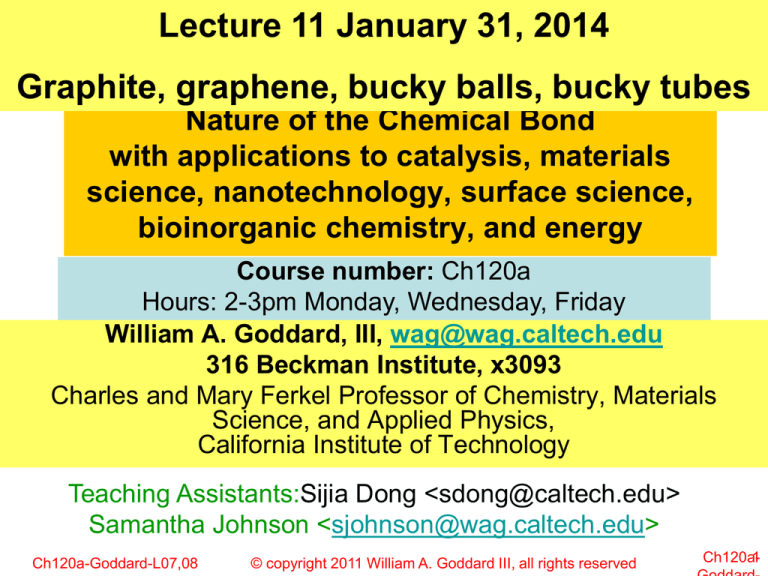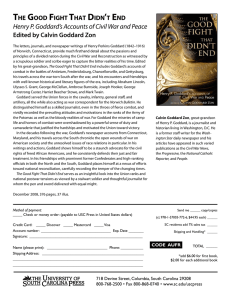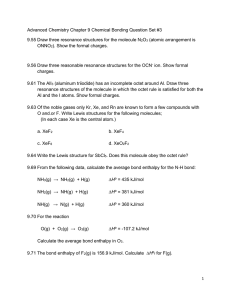
Lecture 11 January 31, 2014
Graphite, graphene, bucky balls, bucky tubes
Nature of the Chemical Bond
with applications to catalysis, materials
science, nanotechnology, surface science,
bioinorganic chemistry, and energy
Course number: Ch120a
Hours: 2-3pm Monday, Wednesday, Friday
William A. Goddard, III, wag@wag.caltech.edu
316 Beckman Institute, x3093
Charles and Mary Ferkel Professor of Chemistry, Materials
Science, and Applied Physics,
California Institute of Technology
Teaching Assistants:Sijia Dong <sdong@caltech.edu>
Samantha Johnson <sjohnson@wag.caltech.edu>
Ch120a-Goddard-L07,08
© copyright 2011 William A. Goddard III, all rights reserved
Ch120a1
From lecture 6
Ch120a-Goddard-L07,08
© copyright 2011 William A. Goddard III, all rights reserved
2
Bond energies
De = EAB(R=∞) - EAB(Re)
Get from QM calculations. Re is
distance at minimum energy
D0 = H0AB(R=∞) - H0AB(Re)
H0=Ee + ZPE is enthalpy at T=0K
ZPE = S(½Ћw)
This is spectroscopic bond energy from
ground vibrational state (0K)
Including ZPE changes bond distance
slightly to R0
Experimental bond enthalpies at 298K and atmospheric pressure
D298(A-B) = H298(A) – H298(B) – H298(A-B)
D298 – D0 = 0∫298 [Cp(A) +Cp(B) – Cp(A-B)] dT =2.4 kcal/mol if A and
B are nonlinear molecules (Cp(A) = 4R). {If A and B are atoms D298
– D0 = 0.9 kcal/mol (Cp(A) = 5R/2)}.
(HCh120a-Goddard-L07,08
= E + pV assuming© an
ideal gas)
3
copyright 2011 William A. Goddard III, all rights reserved
Snap Bond Energy: Break bond without relaxing the fragments
Snap
DErelax = 2*7.3 kcal/mol
Adiabatic
D
Desnap (109.6snap
kcal/mol) De (95.0kcal/mol)
Ch120a-Goddard-L07,08
© copyright 2011 William A. Goddard III, all rights reserved
4
CH2 +CH2 ethene
Starting with two methylene radicals (CH2) in the
ground state (3B1) we can form ethene
(H2C=CH2) with both a s bond and a p bond.
3B
3B
1
1
3B
1
The HCH angle in CH2 was 132.3º, but Pauli Repulsion with
the new s bond, decreases this angle to 117.6º (cf with 120º
for CH3)
Ch120a-Goddard-L07,08
© copyright 2011 William A. Goddard III, all rights reserved
5
Twisted ethene
Consider now the case where the plane of one CH2 is rotated by
90º with respect to the other (about the CC axis)
This leads only to a s bond. The
nonbonding pl and pr orbitals can be
combined into singlet and triplet states
Here the singlet state is referred to as N (for Normal) and the
triplet state as T.
Since these orbitals are orthogonal, Hund’s rule suggests that T is
lower than N (for 90º). The Klr ~ 0.7 kcal/mol so that the splitting
should be ~1.4 kcal/mol.
Voter, Goodgame, and Goddard [Chem. Phys. 98, 7 (1985)] showed that N is
below
T by 1.2 kcal/mol, due
to Intraatomic
Exchange
(s,p
same center)
Ch120a-Goddard-L07,08
© copyright
2011 William A.
Goddard III, all
rightson
reserved
6
Twisting potential surface for ethene
The twisting potential surface for ethene is shown below. The
N state prefers θ=0º to obtain the highest overlap while the T
state prefers θ=90º to obtain the lowest overlap
Ch120a-Goddard-L07,08
© copyright 2011 William A. Goddard III, all rights reserved
7
CC double bond energies
The bond energies for ethene are
De=180.0, D0 = 169.9, D298K = 172.3 kcal/mol
Breaking the double bond of ethene, the HCH bond angle
changes from 117.6º to 132.xº, leading to an increase of 2.35
kcal/mol in the energy of each CH2 so that
Desnap = 180.0 + 4.7 = 184.7 kcal/mol
Since the Desnap = 109.6 kcal/mol, for H3C-CH3,
The p bond adds 75.1 kcal/mol to the bonding.
Indeed this is close to the 65kcal/mol rotational barrier.
For the twisted ethylene, the CC bond is De = 180-65=115
Desnap = 115 + 5 =120. This increase of 10 kcal/mol compared to
ethane might indicate the effect of CH repulsions
Ch120a-Goddard-L07,08
© copyright 2011 William A. Goddard III, all rights reserved
8
bond energy of F2C=CF2
The snap bond energy for the double bond of ethene of
Desnap = 180.0 + 4.7 = 184.7 kcal/mol
As an example of how to use this consider
the bond energy of F2C=CF2,
Here the 3B1 state is 57 kcal/higher than 1A1
so that the fragment relaxation is 2*57 = 114
kcal/mol, suggesting that the F2C=CF2 bond
energy is Dsnap~184-114 = 70 kcal/mol.
3B
1
57 kcal/mol
The experimental value is D298 ~ 75
kcal/mol, close to the prediction
Ch120a-Goddard-L07,08
© copyright 2011 William A. Goddard III, all rights reserved
1A
1
9
CC triple bonds
Since the first CCs bond is De=95 kcal/mol and the first CCp
bond adds 85 to get a total of 180, one might wonder why the
CC triple bond is only 236, just 55 stronger.
The reason is that forming the triple bond
requires promoting the CH from 2P to 4S-,
which costs 17 kcal each, weakening the
bond by 34 kcal/mol. Adding this to the 55
would lead to a total 2nd p bond of 89
kcal/mol comparable to the first
Ch120a-Goddard-L07,08
2P
4S-
© copyright 2011 William A. Goddard III, all rights reserved
10
Ch120a-Goddard-L07,08
© copyright 2011 William A. Goddard III, all rights reserved
11
Cn
What is the structure of C3?
Ch120a-Goddard-L07,08
© copyright 2011 William A. Goddard III, all rights reserved
12
Cn
Ch120a-Goddard-L07,08
© copyright 2011 William A. Goddard III, all rights reserved
13
Energetics Cn
Note extra stability of odd Cn by 33 kcal/mol, this is because odd
Cn has an empty px orbital at one terminus and an empty py on the
other, allowing stabilization of both p systems
Ch120a-Goddard-L07,08
© copyright 2011 William A. Goddard III, all rights reserved
14
Stability of odd Cn
Ch120a-Goddard-L07,08
© copyright 2011 William A. Goddard III, all rights reserved
15
Ch120a-Goddard-L07,08
© copyright 2011 William A. Goddard III, all rights reserved
16
Bond energies and thermochemical calculations
Ch120a-Goddard-L07,08
© copyright 2011 William A. Goddard III, all rights reserved
17
Bond energies and thermochemical calculations
Ch120a-Goddard-L07,08
© copyright 2011 William A. Goddard III, all rights reserved
18
Heats of Formation
Ch120a-Goddard-L07,08
© copyright 2011 William A. Goddard III, all rights reserved
19
Heats of Formation
Ch120a-Goddard-L07,08
© copyright 2011 William A. Goddard III, all rights reserved
20
Heats of Formation
Ch120a-Goddard-L07,08
© copyright 2011 William A. Goddard III, all rights reserved
21
Heats of Formation
Ch120a-Goddard-L07,08
© copyright 2011 William A. Goddard III, all rights reserved
22
Bond energies
Ch120a-Goddard-L07,08
© copyright 2011 William A. Goddard III, all rights reserved
23
Bond energies
Ch120a-Goddard-L07,08
© copyright 2011 William A. Goddard III, all rights reserved
24
Bond energies
Both secondary
Ch120a-Goddard-L07,08
© copyright 2011 William A. Goddard III, all rights reserved
25
Ch120a-Goddard-L07,08
© copyright 2011 William A. Goddard III, all rights reserved
26
Average bond energies
Ch120a-Goddard-L07,08
© copyright 2011 William A. Goddard III, all rights reserved
27
Average bond energies
Ch120a-Goddard-L07,08
© copyright 2011 William A. Goddard III, all rights reserved
28
Real bond energies
Average bond
energies of little
use in predicting
mechanism
Ch120a-Goddard-L07,08
© copyright 2011 William A. Goddard III, all rights reserved
29
Group values
Ch120a-Goddard-L07,08
© copyright 2011 William A. Goddard III, all rights reserved
30
Group functions of propane
Ch120a-Goddard-L07,08
© copyright 2011 William A. Goddard III, all rights reserved
31
Examples of using
group values
Ch120a-Goddard-L07,08
© copyright 2011 William A. Goddard III, all rights reserved
32
Group values
Ch120a-Goddard-L07,08
© copyright 2011 William A. Goddard III, all rights reserved
33
Strain
Ch120a-Goddard-L07,08
© copyright 2011 William A. Goddard III, all rights reserved
34
Strain energy cyclopropane from Group values
Ch120a-Goddard-L07,08
© copyright 2011 William A. Goddard III, all rights reserved
35
Strain
energy
c-C3H6
using real
bond
energies
Ch120a-Goddard-L07,08
© copyright 2011 William A. Goddard III, all rights reserved
36
Stained GVB orbitals of cyclopropane
Ch120a-Goddard-L07,08
© copyright 2011 William A. Goddard III, all rights reserved
37
Benson Strain energies
Ch120a-Goddard-L07,08
© copyright 2011 William A. Goddard III, all rights reserved
38
Allyl radical
Ch120a-Goddard-L07,08
© copyright 2011 William A. Goddard III, all rights reserved
39
Allyl Radical
Ch120a-Goddard-L07,08
© copyright 2011 William A. Goddard III, all rights reserved
40
Allyl wavefunctions
It is about 12 kcal/mol
Ch120a-Goddard-L07,08
© copyright 2011 William A. Goddard III, all rights reserved
41
Resonance in thermochemical Calculations
Ch120a-Goddard-L07,08
© copyright 2011 William A. Goddard III, all rights reserved
42
Resonance in thermochemical Calculations
Ch120a-Goddard-L07,08
© copyright 2011 William A. Goddard III, all rights reserved
43
Resonance energy butadiene
Ch120a-Goddard-L07,08
© copyright 2011 William A. Goddard III, all rights reserved
44
Benzene resonance
Ch120a-Goddard-L07,08
© copyright 2011 William A. Goddard III, all rights reserved
45
Benzene resonance
Ch120a-Goddard-L07,08
© copyright 2011 William A. Goddard III, all rights reserved
46
Benzene resonance
Ch120a-Goddard-L07,08
© copyright 2011 William A. Goddard III, all rights reserved
47
Benzene resonance
Ch120a-Goddard-L07,08
© copyright 2011 William A. Goddard III, all rights reserved
48
Benzene resonance
Ch120a-Goddard-L07,08
© copyright 2011 William A. Goddard III, all rights reserved
49
Benzene and Resonance
referred to as Kekule or VB structures
Ch120a-Goddard-L07,08
© copyright 2011 William A. Goddard III, all rights reserved
50
Resonance
Ch120a-Goddard-L07,08
© copyright 2011 William A. Goddard III, all rights reserved
51
Benzene wavefunction
is a superposition of the VB structures in (2)
benzene as
≡
Ch120a-Goddard-L07,08
+
© copyright 2011 William A. Goddard III, all rights reserved
52
More on resonance
That benzene would have a regular 6-fold symmetry is not
obvious. Each VB spin coupling would prefer to have the
double bonds at ~1.34A and the single bond at ~1.47 A (as
the central bond in butadiene)
Thus there is a cost to distorting the structure to have equal
bond distances of 1.40A.
However for the equal bond distances, there is a
resonance stabilization that exceeds the cost of distorting
the structure, leading to D6h symmetry.
Ch120a-Goddard-L07,08
© copyright 2011 William A. Goddard III, all rights reserved
53
Cyclobutadiene
For cyclobutadiene, we have the same situation, but here the
rectangular structure is more stable than the square.
That is, the resonance energy does not balance the cost of
making the bond distances equal.
1.34 A
1.5x A
The reason is that the pi bonds must be orthogonalized,
forcing a nodal plane through the adjacent C atoms, causing
the energy to increase dramatically as the 1.54 distance is
reduced to 1.40A.
For benzene only one nodal plane makes the pi bond
orthogonal
to both other
bonds,
leading
to lower
cost
Ch120a-Goddard-L07,08
© copyright
2011 William
A. Goddard
III, all rights
reserved
54
graphene
Graphene: CC=1.4210A
Bond order = 4/3
Benzene: CC=1.40 BO=3/2
Ethylene: CC=1.34 BO = 2
CCC=120°
Unit cell has 2 carbon atoms
1x1 Unit cell
This is referred to as graphene
Ch120a-Goddard-L07,08
© copyright 2011 William A. Goddard III, all rights reserved
55
Graphene band structure
1x1 Unit cell
Unit cell has 2 carbon atoms
Bands: 2pp orbitals per cell
2 bands of states each with N states
where N is the number of unit cells
2 p electrons per cell 2N electrons for
N unit cells
The lowest N MOs are doubly occupied,
leaving N empty orbitals.
The filled 1st band touches
the empty 2nd band at the
Fermi energy
Get semi metal
Ch120a-Goddard-L07,08
2nd band
1st band
© copyright 2011 William A. Goddard III, all rights reserved
56
Graphite
Stack graphene layers as ABABAB
Can also get ABCABC Rhombohedral
AAAA stacking much higher in energy
Distance between layers = 3.3545A
CC bond = 1.421
Only weak London dispersion
attraction between layers
De = 1.0 kcal/mol C
Easy to slide layers, good lubricant
Graphite: D0K=169.6 kcal/mol, in plane bond = 168.6
Thus average in-plane bond = (2/3)168.6 = 112.4 kcal/mol
112.4 = sp2 s + 1/3 p
Diamond: average CCs = 85 kcal/mol p = 3*27=81 kcal/mol
Ch120a-Goddard-L07,08
© copyright 2011 William A. Goddard III, all rights reserved
57
energetics
Ch120a-Goddard-L07,08
© copyright 2011 William A. Goddard III, all rights reserved
58
Stopped Feb. 4, 2013
Ch120a-Goddard-L07,08
© copyright 2011 William A. Goddard III, all rights reserved
59
Graphene: generalize benzene in all directions
Ch120a-Goddard-L07,08
© copyright 2011 William A. Goddard III, all rights reserved
60
Have to terminate graphene: two simple cases
Armchair edge
Zig-zag edge
For each edge
atom break two
sp2 sigma bonds
but form bent pi
bond in plane
For each edge
atom break sp2
sigma bond,
maybe not break
pi bond?
111.7 – 20 = 92
kcal/mol
111.7/2 = 56
kcal/mol per
dangling bond
Length =
3*1.4=4.2A
22 kcal/molA
Thus both
graphene
ribbon surfaces
(edges) have
similar
energies
Ch120a-Goddard-L07,08
Length =
1.4*sqrt(3)=
2.42A
23 kcal/mol/A
© copyright 2011 William A. Goddard III, all rights reserved
61
C60 flat sheet
Cut from graphene
6 arm chair pairs @92
5 zig-zag atoms @56
Total cost 832 kcal/mol!
Ch120a-Goddard-L07,08
© copyright 2011 William A. Goddard III, all rights reserved
62
C60 fullerene
No broken bonds
Just ~11.3 kcal/mol
strain at each atom
678 kcal/mol
Compare with 832
kcal/mol for flat sheet
Lower in energy than flat
sheet by 154 kcal/mol!
Ch120a-Goddard-L07,08
© copyright 2011 William A. Goddard III, all rights reserved
63
First observation
Heath, Smalley, Krotos
Laser evaporation of carbon + supersonic nozzle
Observe various sized clusters in mass spect
Change various conditions found peak at C60!
Smalley and Krotos each independently postulated futball
(soccer ball structure) ~1986
^ H. W. Kroto, J. R. Heath, S. C. O'Brien, R. F. Curl and R.
E. Smalley (1985). "C60: Buckminsterfullerene". Nature
318: 162–163. doi:10.1038/318162a0.
Ch120a-Goddard-L07,08
© copyright 2011 William A. Goddard III, all rights reserved
64
Nature 1985: discovery of C60
Ch120a-Goddard-L07,08
© copyright 2011 William A. Goddard III, all rights reserved
65
10 torr He
Evidence for C60, Nature 1985
maximize clustercluster reactions
in integration cup
760 torr He
Ch120a-Goddard-L07,08
© copyright 2011 William A. Goddard III, all rights reserved
66
1985-1990 Many papers on C60, no definitive proof that it had
fullerene structure, lots of skepticism
Ch120a-Goddard-L07,08
© copyright 2011 William A. Goddard III, all rights reserved
67
1985-1990 Many papers on C60, no definitive proof that it had
fullerene structure, lots of skepticism
In 1990 physicists W. Krätschmer and D.R. Huffman for the first
time produced isolable quantities of C60 by causing an arc
between two graphite rods to burn in a helium atmosphere and
extracting the carbon condensate so formed using an organic
solvent.
Then, Nature 347, 354 - 358 (27 September 1990)
W. Krätschmer, Lowell D. Lamb, K. Fostiropoulos & Donald
R. Huffman; Solid C60: a new form of carbon
A new form of pure, solid carbon has been synthesized
consisting of a somewhat disordered hexagonal close
packing of soccer-ball-shaped C60 molecules.
Infrared spectra and X-ray diffraction studies of the molecular
packing confirm that the molecules have the anticipated
'fullerene' structure.
Mass spectroscopy shows that the C70 molecule is present
68
Ch120a-Goddard-L07,08
copyright 2011
Goddard
III, all rights reserved
at ©levels
of aWilliam
fewA. per
cent.
Nature 1990, Krätschmer, Lamb, Fostiropoulos, Huffman
Sears arc welder with
flowing He, get soot of
C60. grams per hour
Ch120a-Goddard-L07,08
© copyright 2011 William A. Goddard III, all rights reserved
70
Carbon 13 NMR spectrum of C60
1 peak
NMR the key
experiment
Definitive proof that
C60 is fullerene
Carbon 13 NMR spectrum of C70
5 peaks, definitive proof of fullerene structure
Ch120a-Goddard-L07,08
© copyright 2011 William A. Goddard III, all rights reserved
71
Polyyne
chain
precursors
Ch120a-Goddard-L07,08
fullerenes, all even
© copyright 2011 William A. Goddard III, all rights reserved
72
Ch120a-Goddard-L07,08
© copyright 2011 William A. Goddard III, all rights reserved
73
C540
All fullerens have 12
pentagonal rings
Ch120a-Goddard-L07,08
© copyright 2011 William A. Goddard III, all rights reserved
74





